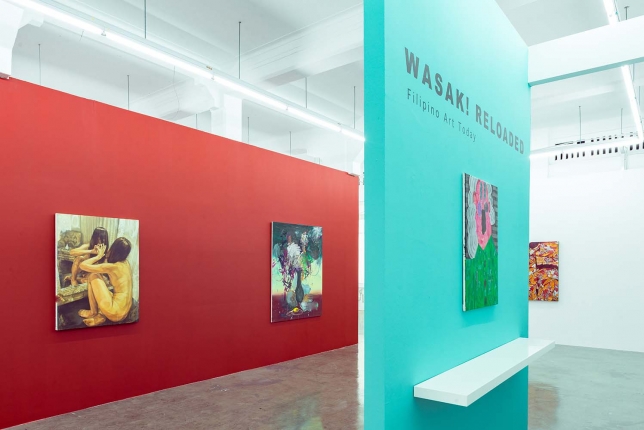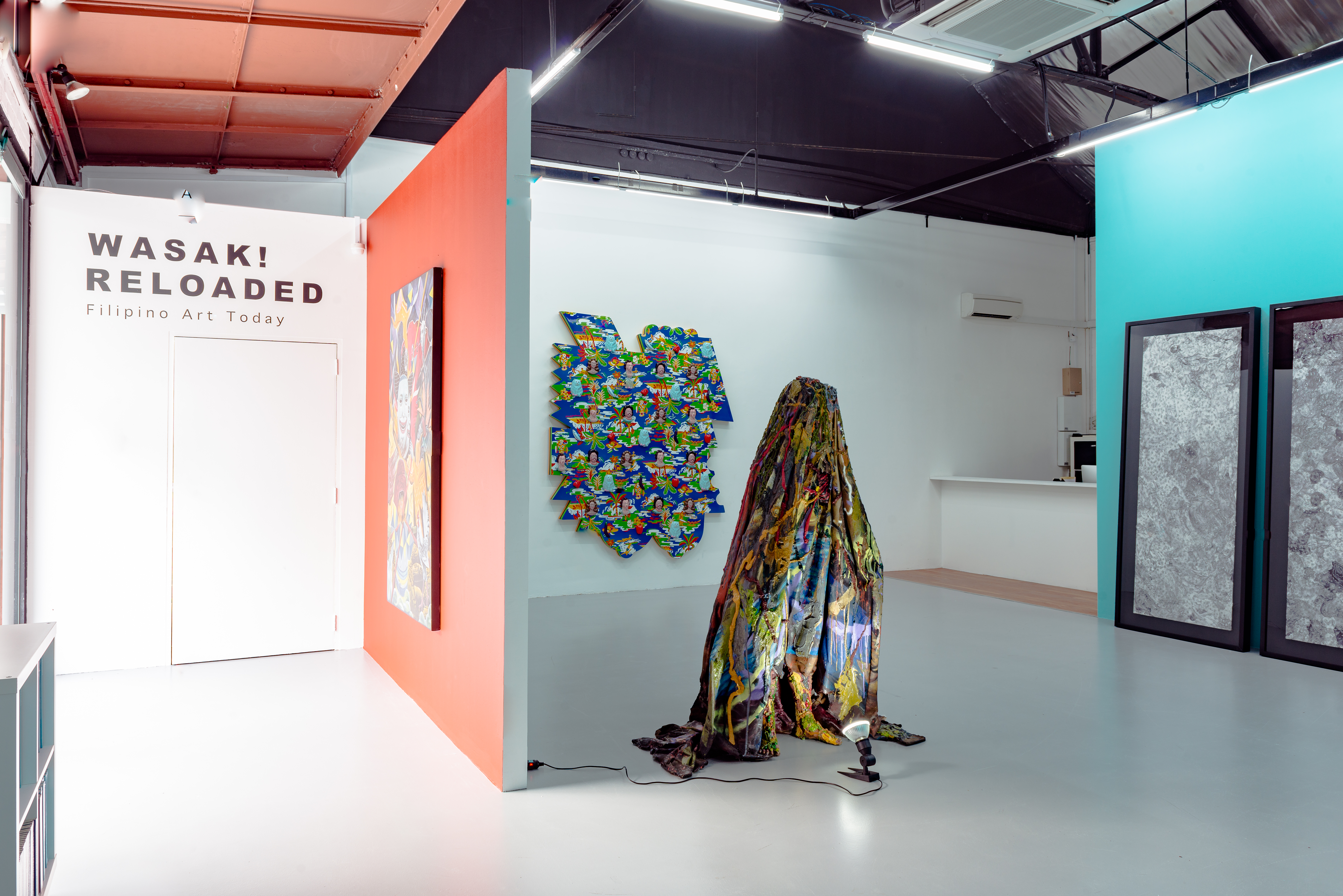Manuel Ocampo
Born 1965 in Quezon City, Philippines
Lives and works in Quezon City, Philippines
“One person’s blasphemy could be another person’s form of spiritual expression.” Thus Manuel Ocampo elucidates on his often misunderstood art forms, stating that if a work starts to offend someone’s tastes and values, then it has succeeded in “staking a claim of its meaning in the world […] as a statement of existence.”
Studying and living in Los Angeles in the early 1990s, Ocampo became part of a new breed of artists who were starting to head in a different direction, away from the career-oriented experiments of the New York scene into more introverted expressions of both banal and multicultural experiences in contemporary America. In 2003, he went back to Manila, where he opened galleries and curated shows with Filipino artists, becoming influential to a number of artists who share the same concerns in challenging the grandiosity and reverence assigned to works of art, especially paintings.
The hard-edged, antagonistic, irreverent, and graphic art of Ocampo met its fair share of controversy during the 1990s. The perceived blasphemy in his works does not essentially occur within the set values of the cultures he chooses to represent, but rather arises within the sterile art world itself. The motivation in each of Ocampo’s new works seems to stem from the idea of a guileless existence. His works simply try to “be,” and in so doing shock us by undermining established taste and values regarding art and beauty. To Ocampo, the associations and agendas overlying paintings have become trite and cumbersome. In his view, the work will always outlast the context.
Behind the explicit images lies a profound inquiry into the notions of artistic creation itself. Sometimes the artist himself becomes the subject of his own parody, being included through the use of text or grotesque figures. Ocampo shatters the special distinctions held for artistic agency, for treating the painter as a maker of worlds. This is why his paintings, rather than being spectacles that generate shock, are challenges to the academies of “bad” and “good” in art. For Ocampo a “bad” painting, if such a thing existed, is a concept that limits the possibilities both of personal imagination and visual culture in general. In his world there are no exemptions; everything is thrown together: religious icons, baroque surfaces, supermarket brands, body parts, bones, and buzzards. The abject qualities that continue to pulsate from his paintings are postscripts to a world that has already been dissolved in the mixture of high and low culture, of canonical and street art.
Selected Solo Exhibitions
2015 The Corrections, Tyler Rollins Fine Art, New York, USA
The Devil Follows Me Day and Night [...], The Drawing Room, Singapore
Black Dada, Nosbaum & Reding, Luxembourg
Goya vu par Ocampo [...], Musée Goya, Castres, France
2014 Notes from the Ste Anne Asylum, Galerie Nathalie Obadia, Paris, France
Beware of Painting, The Crucible Gallery, Mandaluyong City, Philippines
2013 The Corrections, SOD Space of Drawings, Copenhagen, Denmark
20 Years of Intestinal Mishaps, Carré Sainte-Anne, Montpellier, France
2012 Cryptic Slaughter, Finale Art File, Makati City, Philippines
The 80s, Topaz Arts, New York, USA
2011 Galerie Zimmermann Kratochwill, Graz, Austria
The Ghost Poo of Painting, philara – Sammlung zeitgenössischer Kunst, Düsseldorf, Germany
KalimanRawlins, Melbourne, Australia
2010 Tyler Rollins Fine Art, New York, USA
2009 Monuments to the Institutional Critique of Myself, Pablo Gallery, Taguig City, Philippines
She Has a Hot Ass, The Gertrude Contemporary, Melbourne, Australia
2007 Guided by Sausage, LE (9) BIS, Saint-Etienne, France
Kitsch Recovery Program, Lizabeth Oliveria Gallery, Los Angeles, USA
2006 No System Can Give the Masses the Proper Social Graces (with Damien Deroubaix), La Maison Rouge, Paris, France
2005 Mumu Territorium, Art Center – SM Megamall, Mandaluyong City, Philippines
New Works, Lieu d’Art Contemporain, Sigean, France
2004 Finale Art File, Mandaluyong City, Philippines
2003 Wunderkammer, Gesellschaft für Gegenwartskunst, Augsburg, Germany
Lee Almighty, Magnet Gallery Katipunan, Quezon City, Philippines
2001 Free Aesthetic Pleasure Now!, Babilonia 1808, Berkeley, USA
2000 Those Long Dormant Pimples of Inattention [...], Sprüth Magers Projekte, Munich, and Galerie Bärbel Grässlin, Frankfurt am Main, Germany
1999 The Nature of Culture (with Gaston Damag), Centro Andaluz de Arte Contemporáneo, Seville, Spain
The Inversion of the Ideal, Galería Soledad Lorenzo, Madrid, Spain
1998 Yo Tambien Soy Pintura, El Museo Extremeño e Iberoamericano de Arte Contemporáneo, Badajoz, Spain
Why Must I Care For a Girl Who Always Scratches Wherever She Itches, Delfina Foundation, London, and Centre Cultural Tecla Sala, Barcelona, Spain
1997 Heridas de la Lengua, Track 16 Gallery, Santa Monica, USA
Hacer Pintura Es Hacer Patria, Galería OMR, Mexico City, Mexico
1996 Annina Nosei Gallery, New York, USA
1995 Galerie Nathalie Obadia, Paris, France
Musée d’art contemporain de Montréal, Canada
1994 Paraiso Abierto a Todos, The Mexican Museum, San Francisco, USA
Jean-Michel Basquiat & Manuel Ocampo, Henry Art Gallery, University of Washington, Seattle, USA
1992 Matrix Berkeley 150, University Art Museum, University of California, Berkeley, USA
1988 Lies, Falls, Hopes, and Megalomania, La Luz de Jesus Gallery, Los Angeles, USA
Selected Group Exhibitions
2015 Come as You Are: Art of the 1990s, Montclair Art Museum, New Jersey,USA, et al. (traveling exhibition)
2012 7th Asia Pacific Triennial of Contemporary Art, Brisbane, Australia
2004 1st Bienal Internacional de Arte Contemporáneo de Sevilla, Spain
2001 Plateau of Mankind, 49th Esposizione Internazionale d’Arte, Venice, Italy
2nd Berlin Biennale, Germany
2000 Made in California: Art, Image, and Identity, 1900–2000, Los Angeles County Museum of Art, USA
Partage d’Exotismes, 5th Biennale d’art contemporain de Lyon, France
1998 At Home and Abroad: 21 Contemporary Filipino Artists, Asian Art Museum of San Francisco, USA
1997 Unmapping the Earth, 2nd Gwangju Biennale, Republic of Korea
1994 Asia/America: Identities in Contemporary Asian American Art, Asia Society, New York, USA
1993 43rd Biennial Exhibition of Contemporary American Painting, Washington, D.C., USA
1992 documenta IX, Kassel, Germany
Helter Skelter: L.A. Art in the 1990s, The Museum of Contemporary Art, Los Angeles, USA
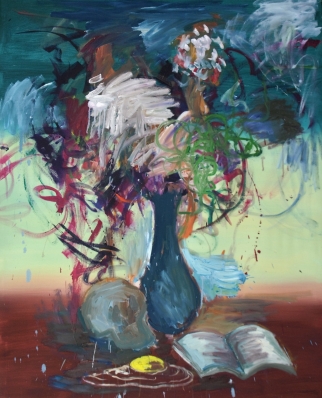 Manuel Ocampo, Lickspittle, 2016, Oil and acrylic on canvas, 160 × 130 cm, OCAM0004
Manuel Ocampo, Lickspittle, 2016, Oil and acrylic on canvas, 160 × 130 cm, OCAM0004
Exhibitions
A3 PRESENTS: WASAK! Filipino Art Today
December 8, 2015 – January 30, 2016
Opening | Saturday | December 5, 2015, 12 - 6 pm
A group exhibition curated by Norman Crisologo and Erwin Romulo across two locations in Berlin at:
ARNDT Berlin Potsdamer Strasse 96 (Tue - Sat, 11am - 6pm)
ARNDT ART AGENCY A3 Fasanenstrasse 28 NEW PREMISES (Wed - Sat, 12 - 6pm)
Exhibiting artists: Zean Cabangis, Annie Cabigting, Buen Calubayan, Louie Cordero, Jigger Cruz, Marina Cruz, Kawayan De Guia, Alfredo Esquillo, Ian Fabro, Nona Garcia, Robert Langenegger, Pow Martinez, Manuel Ocampo, Alwin Reamillo, Norberto Roldan, Kaloy Sanchez, José Santos III, Rodel Tapaya, Tatong Torres and Ronald Ventura.
A publication has been published by DISTANZ Verlag to accompany the exhibition.
View the complete publication HERE.
The underlying motivation of the exhibition and accompanying publication in Berlin is to shed light on the fascinating contemporary art landscape in the Philippines. WASAK! explores Filipino contemporary art, in the hope of providing an emblematic contextual compendium for western audiences. Signaling the first instance of its kind, WASAK! thus offers snapshots of current artistic practices from the Philippines, uniting a selection of its leading protagonists across generational lines, genres, and media.
All of the 19 participating artists included have witnessed the social and political upheaval of Philippines’ recent history. Most of these artists spent their maturation grappling with local events that have transpired such as: natural disasters like earthquakes and floods; political unrest in the form of coup d’état and calls to presidential impeachments; political ineptitude in the form of corruption and briberies; and longstanding bouts with poverty and urban overpopulation. This selection of artists have nurtured, or at least, directed their ideas into the reality that is Manila, the nation’s capital, from where most of the country’s bizarre undulations spring.
Although much of their work is inspired by their own localities, these artists continue to seek their place among the rest of the world. Through the jumble and mess of their own ground zero—which is a country of broken histories, a nation of lush influences, and a people constantly having to live despite of something—their art continued to become, individually, more diverse and yet collectively, as a single exploded view. ‘Wasak’ is a Filipino word that means “in ruins.” When used in the vernacular, it means “wrecked,” or as a more encouraging interjection—it can also mean “going for broke.” It is a term that signals a hazard.
In this field of scattered landscapes, of broken narratives and loose continuity, what then could be ascribed as Philippine Art? The artists represented in WASAK! have come from the different potholes this gap has created, which explains the varying degrees how their work tries to explain not only a locality, but their own place in art history.
In a 1979 essay, one of the most influential Filipino art critic, Leo Benesa, asked the question: “What is Philippine in Philippine Art?” Knowing how any kind of art from any other place cannot escape the influence of the Western canon, he settled with a more optimistic response in implying that the intention of the artist to paint well is what makes them Filipino: “Painters first, and bearers of message, second,” he concluded. The majority of the artists in the show have chosen painting as their primary medium, with a few exceptions that have dealt primarily with assemblage and sculpture. In looking at their paintings, trying to find out what special place they hold, we can follow Benesa’s prescription—to look at the form first, and then deal with the message later. To try to understand, before anything else, that their intention is to do something which is relevant for them, before handing out a prognosis that casts them as representatives of an aesthetic sensibility, a socio-historical period, or worse, a movement.
The 19 artists covered in WASAK! provide us with an opportunity to experience the different directions they have wandered into—a chance to view a small course of history that is finding its way into the arts.
ARNDT Berlin
Potsdamer Strasse 96
10785 Berlin
info@arndtberlin.com
+49 30 2061 3870
ARNDT ART AGENCY A3
Fasanenstrasse 28
10719 Berlin
contact@arndtartagency.com
+49 30 2061 3870
PRESS
Randian | WASAK! | 7 April, 2016
Coconuts Manila | There’s an exhibit of PH contemporary art in Berlin and it’s called…'Wasak' | 15 January 2016
Zitty Berlin | „Wasak!“ zeigt Bilder aus einem katholischen Asien | 14 January 2016
Art Radar | WASAK! Filipino Art Today at ARNDT Berlin | 12 January 2016
Kunst und Film | WASAK! Filipino Art Today | January 2016
Artsy | ARNDT Explores the Complexities of Filipino Art in New Berlin Gallery Space | 12 January 2016
Financial Times | The Art Market: All about agencies | 18 December 2015
Blouin artinfo | ARNDT Opens new Berlin Venue With Filipino Art Shows | 11 December 2015
Taz | Kunstraum | Land der Brüche - Kunst aus den Philippinen | 10 December 2015
Artnet | Arndt Gallery Opens New Upmarket Location in West Berlin | 3 December 2015
Inquirer | Filipino Art Exhibit WASAK! to open new gallery in Berlin | 26 November 2015
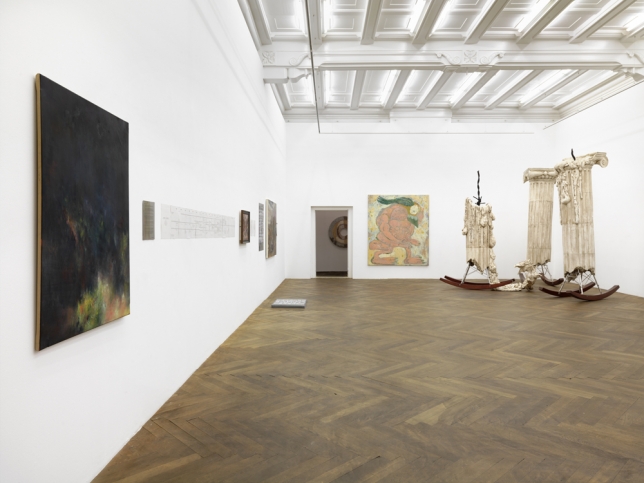 Installation view, WASAK! Filipino Art Today, ARNDT Berlin, 2015
Installation view, WASAK! Filipino Art Today, ARNDT Berlin, 2015
 Installation view, WASAK! Filipino Art Today, ARNDT Berlin, 2015
Installation view, WASAK! Filipino Art Today, ARNDT Berlin, 2015
 Installation view, WASAK! Filipino Art Today, ARNDT Berlin, 2015
Installation view, WASAK! Filipino Art Today, ARNDT Berlin, 2015
 Installation view, WASAK! Filipino Art Today, ARNDT Berlin, 2015
Installation view, WASAK! Filipino Art Today, ARNDT Berlin, 2015
 Installation view, WASAK! Filipino Art Today, ARNDT Berlin, 2015
Installation view, WASAK! Filipino Art Today, ARNDT Berlin, 2015
 Installation view, WASAK! Filipino Art Today, ARNDT Berlin, 2015
Installation view, WASAK! Filipino Art Today, ARNDT Berlin, 2015
 Installation view, WASAK! Filipino Art Today, ARNDT Berlin, 2015
Installation view, WASAK! Filipino Art Today, ARNDT Berlin, 2015
 Installation view, WASAK! Filipino Art Today, ARNDT ART AGENCY (A3), 2015
Installation view, WASAK! Filipino Art Today, ARNDT ART AGENCY (A3), 2015
 Installation view, WASAK! Filipino Art Today, ARNDT ART AGENCY (A3), 2015
Installation view, WASAK! Filipino Art Today, ARNDT ART AGENCY (A3), 2015
 Installation view, WASAK! Filipino Art Today, ARNDT ART AGENCY (A3), 2015
Installation view, WASAK! Filipino Art Today, ARNDT ART AGENCY (A3), 2015
 Installation view, WASAK! Filipino Art Today, ARNDT ART AGENCY (A3), 2015
Installation view, WASAK! Filipino Art Today, ARNDT ART AGENCY (A3), 2015
 Installation view, WASAK! Filipino Art Today, ARNDT ART AGENCY (A3), 2015
Installation view, WASAK! Filipino Art Today, ARNDT ART AGENCY (A3), 2015
 Installation view, WASAK! Filipino Art Today, ARNDT ART AGENCY (A3), 2015
Installation view, WASAK! Filipino Art Today, ARNDT ART AGENCY (A3), 2015
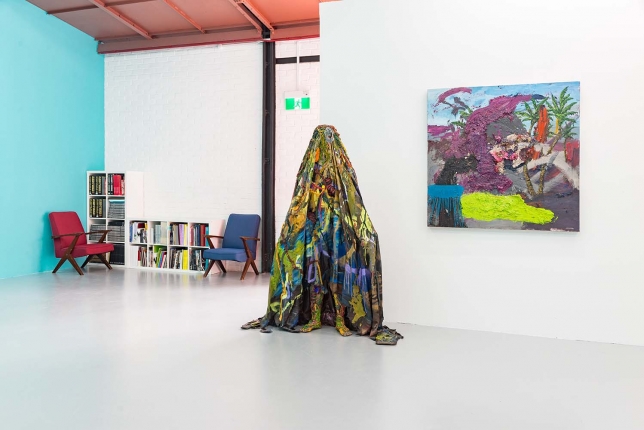 "WASAK! Reloaded", installation view at ARNDT Fine Art, Singapore
"WASAK! Reloaded", installation view at ARNDT Fine Art, Singapore
WASAK! Reloaded
Group Exhibition of Filipino Art Today
27 August - 8 October 2016
Opening | Saturday | August 27, 2016, 12 - 5 pm | ARNDT Fine Art, Singapore
WASAK! Reloaded is a group exhibition exploring the Filipino contemporary art landscape and is accompanied by a major hard copy publication WASAK! Filipino Art Today published by European publisher DISTANZ Verlag. The show is a continuation of the well-received group exhibition presented in Berlin in 2015, and will travel to Gazelli Art House in London in 2017.
Exhibiting artists include: Zean Cabangis, Louie Cordero, Jigger Cruz, Marina Cruz, Kawayan De Guia, Alfredo Esquillo, Ian Fabro, Robert Langenegger, Jason Montinola, Pow Martinez, Manuel Ocampo, Norberto Roldan, Kaloy Sanchez, Rodel Tapaya and Ronald Ventura.
The underlying motivation of WASAK! and its accompanying publication is to shed light on the fascinating contemporary art currently being produced in the Philippines. By offering an overview of Filipino contemporary art, WASAK! aims to provide an emblematic contextual compendium. Uniting a selection of leading protagonists across generational lines, genres, and media, the exhibition presents snapshots of current artistic practices from the Philippines.
The 17 participating artists have witnessed the social and political upheaval of Philippines’ recent history. Most of these artists spent their maturation grappling with local events that have transpired such as: natural disasters like earthquakes and floods; political unrest in the form of coup d’état and calls to presidential impeachments; political ineptitude in the form of corruption and briberies; and longstanding bouts with poverty and urban overpopulation. This selection of artists have nurtured, or at least, directed their ideas into the reality that is Manila, the nation’s capital, from where most of the country’s bizarre undulations spring.
Although much of the artists´ work is inspired by their own localities, these artists continue to seek their place among the rest of the world. Through the jumble and mess of their own ground zero—which is a country of broken histories, a nation of lush influences, and a people constantly having to live despite of something—their art continued to become, individually, more diverse and yet collectively, as a single exploded view. ‘Wasak’ is a Filipino word that means “in ruins.” When used in the vernacular, it means “wrecked,” or as a more encouraging interjection—it can also mean “going for broke.” It is a term that signals a hazard.
In this field of scattered landscapes, of broken narratives and loose continuity, what then could be ascribed as Philippine Art? The artists represented in WASAK! have come from the different potholes this gap has created, which explains the varying degrees how their work tries to explain not only a locality, but their own place in art history.
The 17 artists covered in WASAK! provide us with an opportunity to experience the different directions they have wandered into—a chance to view a small course of history that is finding its way into the arts.
Press Contact:
Pey Chuan Tan
peychuan@arndtfineart.com
+65 9111 3203
Venue:
ARNDT Fine Art Pte Ltd
Gillman Barracks
47 Malan Road #01-25
Singapore 109444
Tel. +65 67340775
Opening hours: Tues - Sat 11am- 7pm, and by appointment
Press:
Blouin ARTINFO | Filipino Artists Present "WASAK! Reloaded" at ARNDT Fine Art | July 21, 2016
Blouin Art Info | Filipino Artists Present ‘WASAK! Reloaded’ at ARNDT Fine Art | July 21, 2016
